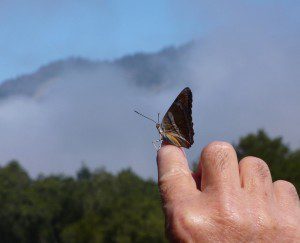Contributing Writer for Wake Up World
Feeling frazzled, depressed or less than healthy? Japanese researchers have discovered that ditching civilization for a few hours can be just what the doctor ordered. Known as shinrin yoku or, more commonly, forest bathing, the practice involves spending time in nature coupled with mindfulness. This simple method has been shown to dramatically reduce health complaints — and can even lower the risk of cancer.
Not having anything to do with bathing in the traditional sense, shinrin yoku is about immersing our senses in the beauty of nature for therapeutic value. The practice was first introduced by the Forest Agency of Japan in 1982 to help reduce stress and encourage relaxation. What wasn’t known at the time, however, was that forest bathing would lead to significant health benefits. Numerous studies have found that spending time mindfully in nature not only soothes the body and mind, but also offers a substantial boost in natural killer (NK) cell activity. NK cells are responsible for keeping cancer cells in check and are a vital component of the immune system.
Qing Li Senior Assistant Professor at Nippon Medical School in Tokyo, has conducted a variety of experiments to examine the effect of forest bathing on mood, stress levels and immunity. According to Healthy Parks, Healthy People Central:
“In two studies, small groups of men and women respectively were assessed before and after a two-night/three-day forest bathing trip. During the trips the subjects went on three forest walks and stayed in a hotel in the forest. Blood tests were taken before and after the trip, revealing a significant boost in NK activity in the subjects in both groups. The increase was observed as long as 30 days after the trip. Follow-up studies showed a significant increase in NK activity was also achieved after a day-trip to a forest, with the increase observed for seven days after the trip.”
Dr. Li believes the increase in NK cell activity is attributed to breathing air infused with the essential oils of trees called phytonicides. These compounds protect trees from disease, insects and fungus — while also helping to boost immunity in people.
 Additionally, Dr. Li oversaw another study comparing the effects of forest bathing on various mental states. Li utilized the Profile of Moods (POMS) test to gauge participants emotional states. The questionnaire was composed of various feeling words like sad, happy, considerate, friendly, etc. Each person indicated how mildly or strongly they experienced each feeling throughout the week. At the conclusion of the study, participants who engaged in forest bathing reported heightened vitality and lower levels of sadness, anxiety and hostility.
Additionally, Dr. Li oversaw another study comparing the effects of forest bathing on various mental states. Li utilized the Profile of Moods (POMS) test to gauge participants emotional states. The questionnaire was composed of various feeling words like sad, happy, considerate, friendly, etc. Each person indicated how mildly or strongly they experienced each feeling throughout the week. At the conclusion of the study, participants who engaged in forest bathing reported heightened vitality and lower levels of sadness, anxiety and hostility.
How to Reap the Benefits of Forest Bathing
The principles behind shinrin yoku are quite straightforward. Basics include carrying adequate water and food, dressing appropriately for the weather and resting often. One of the main points to keep in mind is that this isn’t a hiking marathon, but rather a gentle stroll through the forest. Silence is also helpful in maintaining a sense of mindfulness. And Shinrin Yoku.org reminds us to breath, relax, wander, touch and listen so that we can fully embrace the practice.
If you cannot break away for a full shinrin yoku experience, don’t underestimate the power of indoor plants and scenic views from windows. As Mother Earth News reports:
“Norwegian research shows that having a plant at or within view of an office workstation significantly decreases the risk of sick leave. A 2010 study from the University of Technology, Sydney, Australia, reported that levels of anger, anxiety, depressive thoughts, and fatigue all reduced over a three-month period, and not just by a little bit—these parameters were reduced by about 40 percent, while reported stress was down by 50 percent. On the other hand, those without the stress buffer of a visible plant indicated that stress levels rose over 20 percent during the study.”
 Moreover, plants located within the radiology department of a hospital were shown to decrease sick leave by an impressive 60 percent. What’s more, a study published in The journal of Japanese Society for Horticultural Science found that potted plants placed in high school classrooms over a four month period substantially lowered visits to the infirmary, compared to those within the same age group who didn’t have exposure to visible plants.
Moreover, plants located within the radiology department of a hospital were shown to decrease sick leave by an impressive 60 percent. What’s more, a study published in The journal of Japanese Society for Horticultural Science found that potted plants placed in high school classrooms over a four month period substantially lowered visits to the infirmary, compared to those within the same age group who didn’t have exposure to visible plants.
In the end, the most important aspect of nature therapy is connection to the natural world — whether a full-fledged forest or a humble houseplant. Whichever type you choose, know that taking time on a regular basis to mindfully appreciate nature’s beauty will profoundly nourish and heal both body and soul.
Shinrin Yoku: The Art of Forest Bathing | Short Film
Article sources:
- Your Brain on Nature by Eva Selhub and Alan Logan, Wiley, 2012
- http://www.hphpcentral.com/article/forest-bathing
- http://www.hphpcentral.com/wp-content/uploads/2010/09/5000-paper-by-Qing-Li2-2.pdf
- http://www.ncbi.nlm.nih.gov/pmc/articles/PMC2793341/
- http://informahealthcare.com/doi/abs/10.1080/08923970600809439%20
- http://www.huffingtonpost.com/2014/07/23/shinrin-yoku-health-benefits_n_5599635.html
- http://www.motherearthnews.com/natural-health/forest-bathing-ze0z1301zgar.aspx?
- http://www.natureandforesttherapy.org/uploads/8/1/4/4/8144400/_phytonocides…/.pdf
- http://spiritualityhealth.com/forest-bathing
Previous articles by Carolanne:
- First U.S. City Produces More Electricity Than It Uses — With 100% Renewable Technology
- Dry Skin Brushing Can Strengthen Immunity, Spark Detoxification and Reverse Aging
- Cannabis Dissolves Cancerous Tumor in Young Infant, Deemed ‘Miracle Baby’ by Physician
- Report Finds Cancer Deaths Have Doubled in Argentina’s GMO Growing Regions
- Is Mold Making You Sick?
- Why Everyone Should be Eating More Hempseed
- Slash your Organic Food Bill by Almost 90 Percent with This One Simple Method
- Autistic Boy with Higher IQ Than Einstein Discovers Gift After Removal from State-Run Therapy
- Enhance Spiritual, Mental and Physical Well-being with a Pineal Gland Detox
- Enterprising Community Aims for Total Food Self-Sufficiency with Free Edible Landscapes
- DIY $2 Self-Watering Garden Bed – Grow Produce Easily, Even in the Toughest Conditions
About the author:
I’m Carolanne — a writer, chef, traveler and enthusiastic advocate for sustainability, organics and joyful living. It’s good to have you here. If you would like to learn more, connect with me at Thrive-Living.net or visit Twitter.com/Thrive_Living.

If you've ever found value in our articles, we'd greatly appreciate your support by purchasing Mindful Meditation Techniques for Kids - A Practical Guide for Adults to Empower Kids with the Gift of Inner Peace and Resilience for Life.
In the spirit of mindfulness, we encourage you to choose the paperback version. Delve into its pages away from screen glare and notifications, allowing yourself to fully immerse in the transformative practices within. The physical book enriches the learning process and serves as a tangible commitment to mindfulness, easily shared among family and friends.
Over the past few years, Wake Up World has faced significant online censorship, impacting our financial ability to stay online. Instead of soliciting donations, we're exploring win-win solutions with our readers to remain financially viable. Moving into book publishing, we hope to secure ongoing funds to continue our mission. With over 8,500 articles published in the past 13 years, we are committed to keeping our content free and accessible to everyone, without resorting to a paywall.








